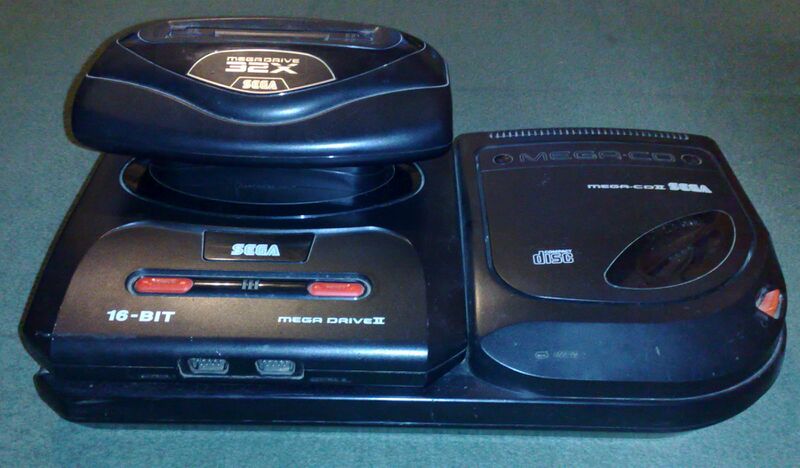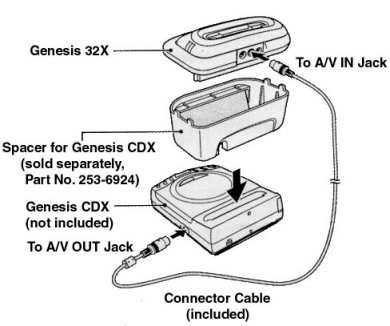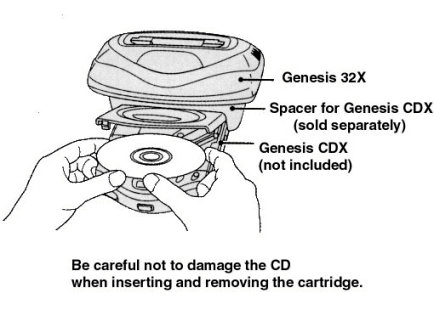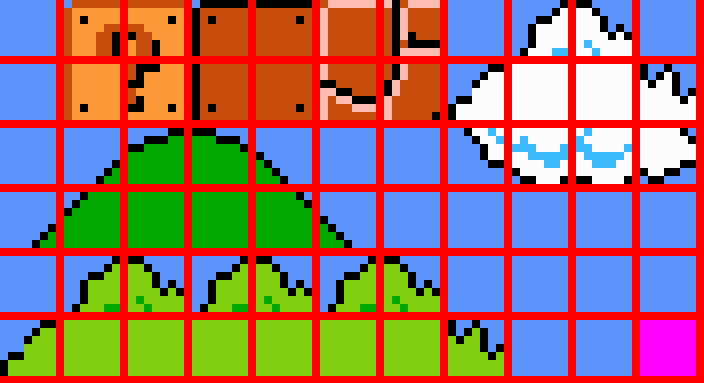
Those games (there were only 5 or 6 of them) required both of the addons. the CD bits were mostly used to add FMV, while the 32X bit improved the in-game graphics (slightly).
As a former proud owner of this monstrosity I concur.

Those games (there were only 5 or 6 of them) required both of the addons. the CD bits were mostly used to add FMV, while the 32X bit improved the in-game graphics (slightly).
32X was definitely a mistake in retrospect but it still has it's moments. Even if just for the quality arcade ports (Virtua Racing DLX, Virtua Fighter, Space Harrier, AfterBurner, Star Wars AC).The Sega CD was full of good ideas and I maintain that it was a good system with a that showed its full potential with Snatcher, Soul Star, and Sonic CD. Unfortunately, there simply wasn't enough games to justify it. It's a beast though, and a nice response to the Super CD ROM.
The 32x was nothing more that a cynical cash crab for one Christmas season and a waste of engineering and development.
Holy crap that's crazy! I would love to see what it looks like in pictures and/or in real life. Just going by the drawings, it looks like a top-heavy monstrosity. Lol.Actually, the 32X does work with the CDX. Sega was set to release an adapter that allowed one to set the 32X on top of the smaller unit, but never actually did. You don't technically need the spacer, but the 32X does interfere with accessing the CD drive without it.



...which is just another Tuesday for '90s Sega.Just going by the drawings, it looks like a top-heavy monstrosity. Lol.
Did you know that the joypad ports on the megadrive could operate like null serial modems? You can pretty easily whip up an arduino interface and get your megadrive online if you know what you are doing.Sega always had hands down the coolest tech. Sega Cd, 32x, sega channel, etc.
Isn't there a 1st person shooter on the system that uses the player-2 controller port to link to another console running the same game for LAN play?Did you know that the joypad ports on the megadrive could operate like null serial modems? You can pretty easily whip up an arduino interface and get your megadrive online if you know what you are doing.
It is indeed a top heavy monstrosity, the 32X only looks right attached to a MD1 + MCD1 tower of power.Holy crap that's crazy! I would love to see what it looks like in pictures and/or in real life. Just going by the drawings, it looks like a top-heavy monstrosity. Lol.

Isn't there a 1st person shooter on the system that uses the player-2 controller port to link to another console running the same game for LAN play?
It is indeed a top heavy monstrosity, the 32X only looks right attached to a MD1 + MCD1 tower of power.


I was pretty much as Team Sega as you could get in the 90s but the 32X was a hard sell at the time even to me.I remember standing by the sidelines as sega descended into madness. I was only fifteen, so you think I would have wanted all this shit. But it was clear that the Sega CD was all fucked up, the 32x is all fucked up, and the 32x CD 'platform' was a double fuckburger.
Stellar post.the sega genesis talks to both peripherals in two different ways. The sega genesis firstly can address 4Mbits of ROM through the cart ports. In actuality, the genesis has TWO cartridge ports, one on the top, and one on the side, which is gender swapped:

The Sega CD is thus seen by the Genesis as a large cartridge attached to the system, except while the Genesis sees the Sega CD as a large chunk of ROM - read only memory -- the addressed data port space on the Sega CD is actually RAM - memory the Sega CD can write to. The Sega CD has two modes of addressing available, one that lets the Genesis see the Sega CD as one giant 256 Kb chunk of memory at once, which only the Genesis or Sega CD can access one at a time, or as two 128 Kb chunks of memory, which can be swapped around. In this dual 128Kb mode, the genesis can access one 128 Kb chunk of memory at the same time the Sega CD can access the other 128 Kb chunk of memory, allowing them to be used like a frame buffer.
The Sega CD itself lacks any sort of hardware to draw to the screen, all drawing is done via the Sega Genesis. Despite this, the Sega CD is almost entirely it's own console otherwise. It has it's own, independently running 68000 CPU -- clocked faster than the Sega Genesis CPU -- it's own RAM, and loads of custom sample based audio hardware more in line with the SNES than the Genesis. It also includes an ASIC chip for fast 3D math, which lets the Sega CD perform hardware scaling and rotation on sets of sprites and tiles. Despite this, because the Sega CD has to use the Genesis to actually draw it's skewed and stretched art, a bottleneck emerges when the Sega CD has to quickly put tiles into the Genesis VRAM; the process is that the Sega CD must internally update some tiles in it's own RAM first using the ASIC, then move them to one of the 128Kb buffers, then swap buffers so the Genesis can see them, then wait for Vblank to DMA a large chunk of tiles from ROM to VRAM. This is why, for example, the special stages in Sonic CD are at a much lower framerate than, say, Super Mario Kart.
The 32X, by contrast, is basically a frame buffer and a Gen Lock running on top of the Genesis. the 32X has it's own completely independent graphics system from the Genesis. Rather than using 8x8 tiles and sprites to draw images on the 32X, the 32X presents the programmer with 2 Direct Color frame buffers which can be configured in memory. There are a few color modes available to the the 32X, including an indexed 256 color palette mode, and a 16 bit per pixel color mode. The benefit of a direct color Frame buffer is that individuals pixels can be plotted on the screen arbitrarily, allowing for things like 3D polygons to be rendered. The 32X also has a hardware fill function, which lets it fill arbitrary areas of memory with solid color (or patterns) which is useful for rasterizing polygons beyond the wireframe.
The 32X interacts with the genesis in a pretty hands off way. the Genesis underneath the 32X runs basically independently of the 32X. where they communicate is in the cartridge, which is addressed by both the 32X and the Sega Genesis. The space in the cart addressed by the Genesis runs 68000 code, and the space in the cart addressed by the 32X runs SH2 code. The limits of the interaction between the 32X and Genesis is basicaly the 32X using the Genesis' controller ports to poll, and the genesis feeding its own video stream externally back into the 32X using a cable. Comparing this again to a Gen Lock, the 32X thusly essentially has two ports -- a video out port that goes to the television, and a video IN port that takes video from the Genesis. This video-in port will take a full frame from the genesis, which gets treated like an independent background layer on the 32X. thus, 32X elements can either appear entirely behind or entirely in front of Genesis graphics, but can't intermingle. You can't, for example, have 32X elements appearing in between layers of a Genesis background. One problem with the 32X -- plotting pixels directly through the CPUs is a bit too much for the 32X to handle every single frame. Games that try to use the 32X to draw every frame entirely in the CPU wind up running at 30 FPS because doing so at 60 FPS is too slow. The Genesis, by comparison, has dedicated tile-based hardware designed to draw backgrounds at 60 FPS, and thus a common use for 32X games is to have high quality "sprite" elements with lots of colors, while letting the Genesis draw the backgrounds at 60 FPS to make the games run fast.
Now, with regards to the 32X and Sega CD, the 32X sees the Sega CD through the shared memory addressed in the cart space. In practice, all* 32X Sega CD games merely used the 32X to output more colors on screen for better full motion video, something the Sega CD could have technically done using Blast Processing on the Sega Genesis. Despite that, it's possible to write a 32X program that can still access and take advantage of the Sega CD and it's AISC like any other genesis game; it's just that doing so is redundant. It's faster to do 3D math entirely on the 32X rather than relying on the AISC due to the memory bottlenecks.
this brings us to a feature of the Sega CD that was never used in any retail game: Mode 1. Mode 1 is a boot mode from the Sega CD where the Genesis boots from a cartridge, but still can address the Sega CD's 128Kb shared memory and thus can access the hardware. This is basically a way for a cart game to access the AISC and sample based sound hardware, without accessing the actual CD ROM drive. Again, no games ever used this mode, because why would you make a game that ran on cart but required the CD hardware to run? CDs were cheaper to produce than carts and contained more space.
*Pier Solar is also technically a 32X CD game, although it uses the hardware in very different ways. Pier Solar doesn't use redbook audio, but rather streaming PCM to send super high quality audio to be played in real time. It can also detect that a 32X is present and will plant small easter eggs in the game if a 32X is present, but otherwise does not use the 32X hardware at all.
early megadrives/Genesis actually had 3 controller ports -- there was one that was gender swapped on the back labeled EXT that was nothing more than a 3rd joystick port. Zero Tolerance used Player 2's port because it was more common, but the actual Mega Modem in japan used the 3rd controller port (i.e. EXT).
My folks got me a 32x and Doom for Christmas. Was pretty salty about the library being trash.
I had no idea there were games that required both the Mega CD and 32X either. That's insane. Those games must have sold pitifully. Sega went nuts.
I wish I could uderstand half of what you wrote but I know a god post when I see it. The most incredible thing I learned was that the Genesis could harness the Sega CD's extra power for its regular Genesis cartridge games but never used that.the sega genesis talks to both peripherals in two different ways. The sega genesis firstly can address 4Mbits of ROM through the cart ports. In actuality, the genesis has TWO cartridge ports, one on the top, and one on the side, which is gender swapped:

The Sega CD is thus seen by the Genesis as a large cartridge attached to the system, except while the Genesis sees the Sega CD as a large chunk of ROM - read only memory -- the addressed data port space on the Sega CD is actually RAM - memory the Sega CD can write to. The Sega CD has two modes of addressing available, one that lets the Genesis see the Sega CD as one giant 256 Kb chunk of memory at once, which only the Genesis or Sega CD can access one at a time, or as two 128 Kb chunks of memory, which can be swapped around. In this dual 128Kb mode, the genesis can access one 128 Kb chunk of memory at the same time the Sega CD can access the other 128 Kb chunk of memory, allowing them to be used like a frame buffer.
The Sega CD itself lacks any sort of hardware to draw to the screen, all drawing is done via the Sega Genesis. Despite this, the Sega CD is almost entirely it's own console otherwise. It has it's own, independently running 68000 CPU -- clocked faster than the Sega Genesis CPU -- it's own RAM, and loads of custom sample based audio hardware more in line with the SNES than the Genesis. It also includes an ASIC chip for fast 3D math, which lets the Sega CD perform hardware scaling and rotation on sets of sprites and tiles. Despite this, because the Sega CD has to use the Genesis to actually draw it's skewed and stretched art, a bottleneck emerges when the Sega CD has to quickly put tiles into the Genesis VRAM; the process is that the Sega CD must internally update some tiles in it's own RAM first using the ASIC, then move them to one of the 128Kb buffers, then swap buffers so the Genesis can see them, then wait for Vblank to DMA a large chunk of tiles from ROM to VRAM. This is why, for example, the special stages in Sonic CD are at a much lower framerate than, say, Super Mario Kart.
The 32X, by contrast, is basically a frame buffer and a Gen Lock running on top of the Genesis. the 32X has it's own completely independent graphics system from the Genesis. Rather than using 8x8 tiles and sprites to draw images on the 32X, the 32X presents the programmer with 2 Direct Color frame buffers which can be configured in memory. There are a few color modes available to the the 32X, including an indexed 256 color palette mode, and a 16 bit per pixel color mode. The benefit of a direct color Frame buffer is that individuals pixels can be plotted on the screen arbitrarily, allowing for things like 3D polygons to be rendered. The 32X also has a hardware fill function, which lets it fill arbitrary areas of memory with solid color (or patterns) which is useful for rasterizing polygons beyond the wireframe.
The 32X interacts with the genesis in a pretty hands off way. the Genesis underneath the 32X runs basically independently of the 32X. where they communicate is in the cartridge, which is addressed by both the 32X and the Sega Genesis. The space in the cart addressed by the Genesis runs 68000 code, and the space in the cart addressed by the 32X runs SH2 code. The limits of the interaction between the 32X and Genesis is basicaly the 32X using the Genesis' controller ports to poll, and the genesis feeding its own video stream externally back into the 32X using a cable. Comparing this again to a Gen Lock, the 32X thusly essentially has two ports -- a video out port that goes to the television, and a video IN port that takes video from the Genesis. This video-in port will take a full frame from the genesis, which gets treated like an independent background layer on the 32X. thus, 32X elements can either appear entirely behind or entirely in front of Genesis graphics, but can't intermingle. You can't, for example, have 32X elements appearing in between layers of a Genesis background. One problem with the 32X -- plotting pixels directly through the CPUs is a bit too much for the 32X to handle every single frame. Games that try to use the 32X to draw every frame entirely in the CPU wind up running at 30 FPS because doing so at 60 FPS is too slow. The Genesis, by comparison, has dedicated tile-based hardware designed to draw backgrounds at 60 FPS, and thus a common use for 32X games is to have high quality "sprite" elements with lots of colors, while letting the Genesis draw the backgrounds at 60 FPS to make the games run fast.
Now, with regards to the 32X and Sega CD, the 32X sees the Sega CD through the shared memory addressed in the cart space. In practice, all* 32X Sega CD games merely used the 32X to output more colors on screen for better full motion video, something the Sega CD could have technically done using Blast Processing on the Sega Genesis. Despite that, it's possible to write a 32X program that can still access and take advantage of the Sega CD and it's AISC like any other genesis game; it's just that doing so is redundant. It's faster to do 3D math entirely on the 32X rather than relying on the AISC due to the memory bottlenecks.
this brings us to a feature of the Sega CD that was never used in any retail game: Mode 1. Mode 1 is a boot mode from the Sega CD where the Genesis boots from a cartridge, but still can address the Sega CD's 128Kb shared memory and thus can access the hardware. This is basically a way for a cart game to access the AISC and sample based sound hardware, without accessing the actual CD ROM drive. Again, no games ever used this mode, because why would you make a game that ran on cart but required the CD hardware to run? CDs were cheaper to produce than carts and contained more space.
*Pier Solar is also technically a 32X CD game, although it uses the hardware in very different ways. Pier Solar doesn't use redbook audio, but rather streaming PCM to send super high quality audio to be played in real time. It can also detect that a 32X is present and will plant small easter eggs in the game if a 32X is present, but otherwise does not use the 32X hardware at all.
Hold on a second, you're joking there right? There is no Blast Processing, man. That was clever marketing spiel from SoA right?Now, with regards to the 32X and Sega CD, the 32X sees the Sega CD through the shared memory addressed in the cart space. In practice, all* 32X Sega CD games merely used the 32X to output more colors on screen for better full motion video, something the Sega CD could have technically done using Blast Processing on the Sega Genesis.
I wish I could uderstand half of what you wrote but I know a god post when I see it. The most incredible thing I learned was that the Genesis could harness the Sega CD's extra power for its regular Genesis cartridge games but never used that.
And boy were the stories right, you ARE a Sega CD 32X guru!
Hold on a second, you're joking there right? There is no Blast Processing, man. That was clever marketing spiel from SoA right?
I used it witouth that just to see if it worked. Never had an isseu with it. Sonic CD worked just fine.Holy crap that's crazy! I would love to see what it looks like in pictures and/or in real life. Just going by the drawings, it looks like a top-heavy monstrosity. Lol.
I wish I could uderstand half of what you wrote but I know a god post when I see it. The most incredible thing I learned was that the Genesis could harness the Sega CD's extra power for its regular Genesis cartridge games but never used that.
And boy were the stories right, you ARE a Sega CD 32X guru!
Hold on a second, you're joking there right? There is no Blast Processing, man. That was clever marketing spiel from SoA right?
depends on the titleWas the 32X required, or did it just enhance graphics if it was available?
a few more colors and played in a bigger window. Both sucked versus the never released VHS versions.
You were that kid in the playground werent you? The one who'd lead the Sega forces into war during recess against the Nintendo brethren didnt ya?I got my Sega Master System for christmas in 86, my Sega Scope 3D glasses in 88, my genesis in 91, my Game gear in 92, my Sega CD in 93, my 32X in 94, my Saturn in 95, and my Dreamcast on 9/9/99. I remember buying the 32X CD version of Supreme Warrior at EB Games and the guy behind the counter going "you know you need a Sega Genesis and a Sega CD to run this, right?" and going "ya" and him going "AND a 32X as well" and going "ya" and the guy going "wow" when he rung me up, lol.
There was going to be a Night Trap on VHS? How would that work?a few more colors and played in a bigger window. Both sucked versus the never released VHS versions.
Stopgap solutionWas the 32x supposed to be a true followup for the 32bit era but was just too underpowered? What was the point in Sega investing in something like the 32x if they were also working on the Saturn?
Huh? Why? Im so confused. For years theyve said it was nothing but a bunch of lies or exagerations at best.Blast processing is a real technique. No retail games ever used it.
I remember standing by the sidelines as sega descended into madness. I was only fifteen, so you think I would have wanted all this shit. But it was clear that the Sega CD was all fucked up, the 32x is all fucked up, and the 32x CD 'platform' was a double fuckburger.
I played it.There was going to be a Night Trap on VHS? How would that work?
And how could you know the VHS version was going to be better is it never came out?
I just looked up a comparison and holy shit I didnt expect the difference between Night Trap on Sega CD vs CD 32X to be this dramatic! I thought it was going to be a PS4 vs XB1 type of comparison where only side by side pixel counting or frame rate analysts could see but nope. Its night and day difference!a few more colors and played in a bigger window. Both sucked versus the never released VHS versions.
Sega of Japan wanted to kill the Mega Drive and move onto a true next-gen console in 1994.Was the 32x supposed to be a true followup for the 32bit era but was just too underpowered? What was the point in Sega investing in something like the 32x if they were also working on the Saturn?
I just looked up a comparison and holy shit I didnt expect the difference between Night Trap on Sega CD vs CD 32X to be this dramatic! I thought it was going to be a PS4 vs XB1 type of comparison where only sie by side pixel cunting or frame rate analysts could see but nope. Its night and day difference!
I just looked up a comparison and holy shit I didnt expect the difference between Night Trap on Sega CD vs CD 32X to be this dramatic! I thought it was going to be a PS4 vs XB1 type of comparison where only sie by side pixel cunting or frame rate analysts could see but nope. Its night and day difference!
Did the Genesis ever only output in Mono or was it possible to output stereo via one of its peripherals or with the Genesis Model 2?
Urm it always output in stereo, actually the first model was the best for soundDid the Genesis ever only output in Mono or was it possible to output stereo via one of its peripherals or with the Genesis Model 2?
No, it was a real technique to push the available color palette far beyond the normal limits that just never saw the light of day in a retail release. Nothing about that video is a joke, as they mentioned marketing latched onto the term and ran with it. In addition to the previously linked video you can also watch this one by Jon Burton of Traveller's Tales showcasing his demo from the era: https://www.youtube.com/watch?v=o8qgArSqMscBut that video was an April's fools video wasnt it? I know the one thing the Genesis did better than the SNES was its clock speed but a Blast Processing? It's long been said it was nothing but a marketing ploy.
Also that video, which I did watch, was incomprehensible for my mortal brain but I wrote it off as an Aprils Fools joke. That and their Bubsy video.
Was the 32x supposed to be a true followup for the 32bit era but was just too underpowered? What was the point in Sega investing in something like the 32x if they were also working on the Saturn?

But that video was an April's fools video wasnt it? I know the one thing the Genesis did better than the SNES was its clock speed but a Blast Processing? It's long been said it was nothing but a marketing ploy.
Also that video, which I did watch, was incomprehensible for my mortal brain but I wrote it off as an Aprils Fools joke. That and their Bubsy video.
Urm it always output in stereo, actually the first model was the best for sound
The most important takeaway of what the 32X was is that it was a couple pretty powerful RISC chips (efficient CPUs with very basic interfaces) and absolutely no 3D hardware besides a dual framebuffer and the ability to do color fills directly to it which enabled relatively efficient flat-shaded polygon drawing, similar to what you might have seen from Out of This World. The framebuffers are 1:1 with the actual output to the screen, which is why trying to use them to draw 2D scrolling was so awful, because you had to basically re-draw everything in them every frame. If it wasn't 1:1 with the screen output then they could have been used to do scaling more along the lines of what the NES was capable of.
That's basically the reason that these 32X CD games only did one thing, which was to provide better-detailed graphics for FMV games. No other types of commercially released games during the period the hardware was still alive existed, only FMV games. The 32X would decode the graphics and then write them to the framebuffer (well, more or less). As you might guess this required both completely disparate game logic to use the hardware setup and a different set of video data to decode. Little wonder that most of these games were either sold separately or had their 32X-compatible mode on a second disc.
Well, there was Flux, the (IIRC, Europe-only) Sega CD cartridge that was basically just a series of visualizers for soundtrack CDs. That is, you'd put in the disc and it would show animations based on the music you were listening to.
It was...it was more impressive in the days before Windows Media Player.
I mean it certainly could have been used like some of the RAM cartridges were used in the Saturn -- or perhaps, more accurately, like the ROM cartridges for a couple of the SNK games on the Saturn.
I mean the basic idea behind the Sega CD made a lot of sense, considering that by the time it was coming out you didn't see very many new PC engine games that weren't on CD. For me I think the biggest issue is that while it did have its own set of VRAM it was used entirely to blit (scaled) graphics to the Genesis VDP's tile ram, and as Krejlooc implied there was a huge bottleneck there. If the console had been designed to either use the "blast processing" setup for the hardware (so that the Sega CD can draw entire screens through CRAM writes to the Genesis) or had some way to write its own graphics without having to poll the Genesis VDP entirely (so that it might be able to take advantage of increased color space or scale its VRAM map in a way similar to how the SNES VDP's mode 7 worked) it would have probably been ridiculously expensive but at least fairly future-proof. Might have had huge consequences for the design of the Saturn too, and I'd say that console's biggest flaws seem like they were the result of trying to design an aggressive backward compatibility setup for Genesis, Sega CD, and possibly even 32X games that never actually amounted to anything.
There appears to be enough circuity in the Genesis VDP that would allow it to be the source of genlock instead of the 32X, though looking over the documents I can't tell if it would be possible to access it or not. The signal would be /YS (as labeled in the VDP documentation and other system bus diagrams) but it doesn't seem like either the cartridge slot or the expansion port (which was, as noted, a clone of the cartridge slot's pin layout) would be able to access it, and there are like 8 pins on the VDP that don't appear to even do anything. I think one of the worst flaws of the 32X was that it required external power and an input patch cable to get data from the system rather than being a plug-and-play setup, but it feels like that was something that was wholly unnecessary had they been more interested in future-proofing the console. I mean, even if someone's got a Genesis with a bad composite encoder, the video out still has RGB lines (which is how the 32X gets in the video data coming from the Genesis in the first place).

